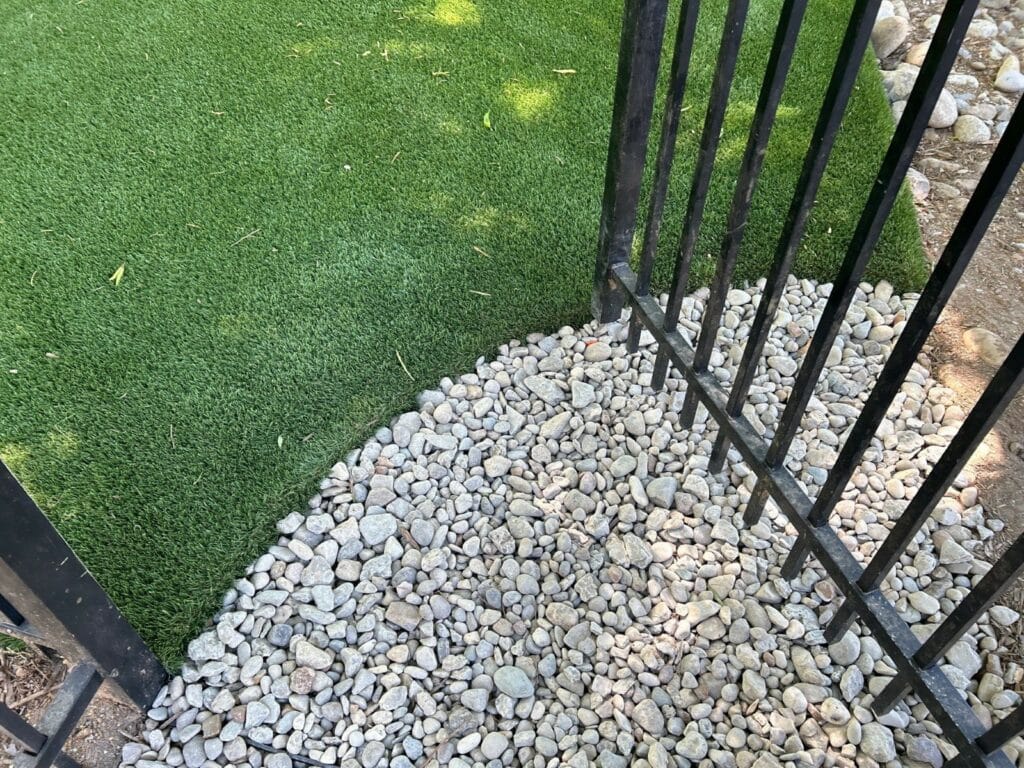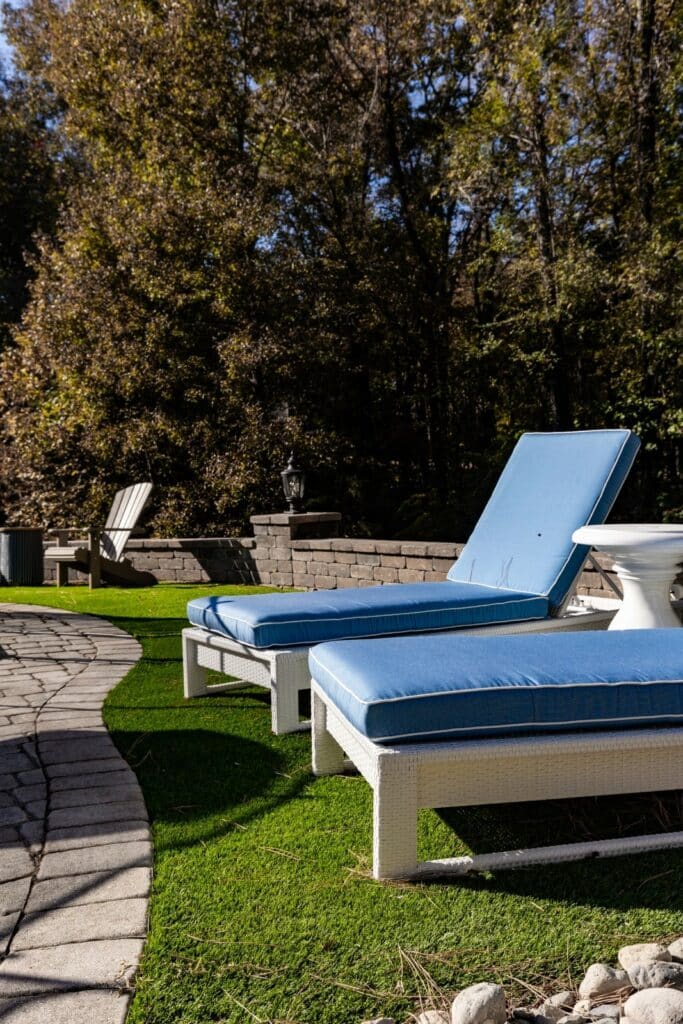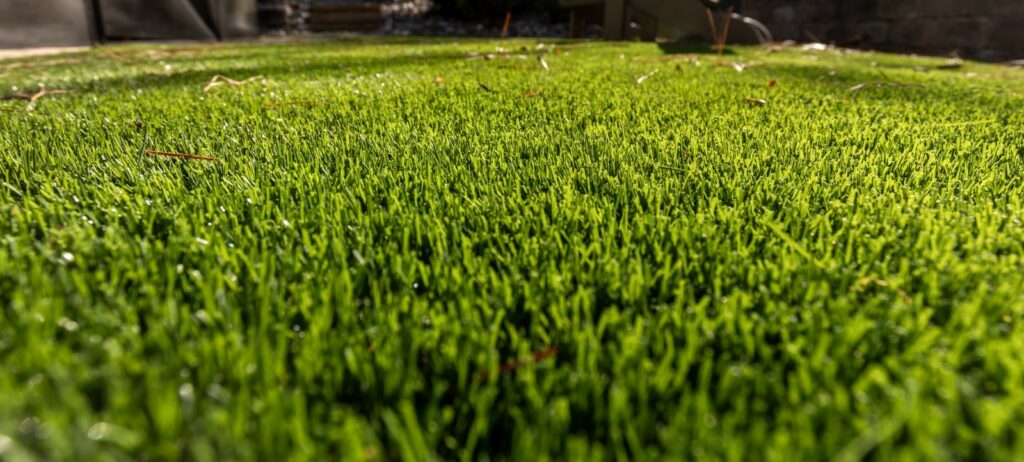Quick Answer:
Wondering whether artificial turf or natural grass is better for your Charlotte home’s environmental impact?
Artificial turf offers significant eco-friendly advantages, including 100% water conservation (saving over 30,000 gallons annually), elimination of chemical fertilizers and pesticides, and reduced carbon emissions from lawn maintenance equipment. While natural grass is biodegradable, it requires substantial water, chemicals, and fossil fuel-powered maintenance that can harm local ecosystems.
Read on for a comprehensive comparison covering water usage, environmental impact, maintenance requirements, and long-term sustainability to help you make the best choice for your Charlotte landscape.
Introduction
When it comes to creating a lush, green lawn, homeowners in Charlotte face a growing question: should they choose traditional natural grass or make the switch to premium artificial turf?
While both have aesthetic appeal, the environmental impact of your ground cover matters, especially at a time when sustainability is at the forefront of luxury landscape design. With increasing awareness of water conservation and chemical reduction in residential landscapes, the choice between artificial turf and natural grass has become more complex than simple aesthetic preference.
This comprehensive guide covers:
- Water conservation strategies and usage comparisons
- Chemical dependency and environmental toxin reduction
- Carbon footprint analysis for maintenance requirements
- Long-term sustainability and lifecycle considerations
- Cost-effectiveness and installation factors specific to Charlotte’s climate
Below, we examine the eco-friendly advantages and disadvantages of both options, considering water conservation, chemical usage, maintenance requirements, and long-term sustainability.

Water-Wise Landscaping: The Turf Advantage
Charlotte’s warm climate and long summers often necessitate heavy lawn watering to keep natural grass green and healthy. In fact, traditional lawns can demand over 30,000 gallons of water per year for a standard 1,000-square-foot yard. During drought conditions or watering restrictions, that need becomes even more problematic.
The Environmental Protection Agency estimates that landscape irrigation accounts for nearly one-third of all residential water use, totaling more than 7 billion gallons per day nationwide. In Charlotte’s humid subtropical climate, where summer temperatures regularly exceed 85°F, natural grass requires consistent watering to prevent dormancy and brown patches.
Artificial turf, on the other hand, requires no irrigation, thereby reducing outdoor water usage immediately. For eco-conscious homeowners or those installing large landscapes with a grass-like aesthetic, turf offers an innovative, sustainable alternative without sacrificing appearance.
Modern artificial turf systems also incorporate advanced drainage technology that prevents water runoff issues common with traditional lawns, helping protect Charlotte’s watershed areas and reducing strain on municipal water treatment facilities.
Chemical Treatment and Fertilizer Use
Natural grass lawns often rely on a routine schedule of fertilizers, herbicides, and pesticides to stay healthy. These chemicals can contribute to groundwater pollution, leading to runoff into local streams, and can also pose health risks to pets and children. The typical Charlotte homeowner spends between $300 and $ 800 annually on lawn chemicals, according to industry data.
Research from the National Wildlife Federation indicates that the average suburban lawn receives 10 times more chemical pesticides per acre than farmland. These chemicals eventually find their way into Charlotte’s water systems, including Lake Norman and the Catawba River, potentially affecting local ecosystems and drinking water quality.
Artificial turf eliminates this chemical dependency. With no need to fertilize or weed, there’s a significant reduction in environmental toxins. Additionally, modern turf systems offer antimicrobial infill options and permeable bases, keeping your yard cleaner and more functional without the need for harmful products. Leading manufacturers, such as FieldTurf, have developed eco-friendly infill materials made from recycled materials that offer natural antimicrobial properties.

The elimination of chemical treatments also means safer outdoor spaces for children and pets, with no worry about toxic exposure from recently treated lawns.
Maintenance and Carbon Footprint
Maintaining natural grass isn’t just about water and chemicals; it also means regular mowing, edging, and equipment use. Gas-powered mowers and blowers contribute to air and noise pollution and, in some cases, also consume fossil fuels. A traditional lawn can require dozens of hours of maintenance per year, resulting in high levels of toxins being released into the air.
The EPA estimates that one gas-powered lawn mower produces as much air pollution in one hour as driving a car for 45 miles. With Charlotte’s growing focus on improving air quality, reducing emissions from landscape maintenance becomes increasingly important for environmental stewardship.
By contrast, artificial turf requires almost no maintenance. Mowing, trimming, or reseeding are no longer necessary; instead, just occasional rinsing and brushing are required. That means fewer emissions, less waste, and more free time for homeowners to enjoy their outdoor spaces rather than tend to them.
Professional turf maintenance typically involves quarterly deep cleaning and annual inspections, significantly reducing the ongoing environmental impact compared to weekly natural grass care. Turf companies will often offer eco-friendly maintenance programs that use biodegradable cleaning solutions and water-efficient techniques.

Installation Considerations for Charlotte’s Climate
Charlotte’s unique climate presents specific challenges for both natural grass and artificial turf installation. The region’s clay soil composition, seasonal temperature variations, and humidity levels all impact the long-term success of ground cover choices.
Natural grass varieties suitable for Charlotte, such as Bermuda, Zoysia, and Tall Fescue, require different establishment periods and care routines. Bermuda grass, while drought-tolerant once established, requires significant water during its establishment phase and goes dormant in winter, creating seasonal aesthetic challenges.
Artificial turf installation in Charlotte requires careful attention to drainage systems, given the area’s clay soil and frequent heavy rainfall. Proper drainage prevents water accumulation and extends the lifespan of turf, making professional installation crucial for optimal performance.
Long-Term Sustainability and Lifespan
Although natural grass is biodegradable and replenishable, it’s not always sustainable in high-use or harsh-climate areas. Constant repair, patching, and replanting often result in added expense and environmental strain.
High-quality artificial turf systems, such as those installed by G&G Landscape Solutions, are designed to last 15–20 years with minimal impact. Many modern turf products are also recyclable at the end of their life cycle. With proper drainage layers, they can support plant beds, hardscapes, and sustainable irrigation systems around them.
Leading manufacturers now offer take-back programs for end-of-life turf products, ensuring materials are properly recycled rather than sent to landfills. Companies like Grass Direct have developed comprehensive recycling programs that process old turf into new products, creating a circular economy approach to artificial turf management.
The manufacturing process for modern artificial turf has also become more sustainable, with many products incorporating recycled materials and utilizing renewable energy in production facilities.
Cost Analysis and Return on Investment
While the initial investment for artificial turf installation typically ranges per square foot in the Charlotte market, the long-term financial and environmental returns often justify the upfront cost. Natural grass requires ongoing expenses for water, fertilizers, pest control, equipment maintenance, and potential replanting costs.
Over the course of 15 years, homeowners can expect to save $3,000-$8,000 in maintenance costs by choosing artificial turf, while simultaneously reducing their environmental footprint. These savings increase during drought years when water restrictions and higher utility costs result in reduced natural grass maintenance.
Conclusion
Choosing between artificial turf and natural grass depends on your specific goals, existing landscaping, and the style of your home. When it comes to eco-friendly performance, artificial turf stands out as a modern, low-impact solution. It supports water conservation, reduces chemical dependency, and minimizes the carbon footprint, all while offering a pristine, year-round green space to enjoy.
For Charlotte homeowners seeking to balance luxury aesthetics with environmental responsibility, artificial turf represents a forward-thinking investment in sustainable landscape design.
Ready to Go Green?
At G&G Landscape Solutions, we combine upscale design with sustainable landscaping practices tailored to Charlotte’s unique climate. A full-service landscape company with over 30 years of experience in the Charlotte metro area, we specialize in custom landscape and hardscape design, luxury outdoor kitchens, expert installation, and ongoing maintenance.
Whether you’re considering artificial turf, eco-conscious plantings, or a complete landscape transformation, our team of landscape design experts is here to help you make a lasting impact with exceptional craftsmanship and luxurious, lasting results in every detail.
Contact us today to schedule a consultation and discover how you can achieve both beauty and sustainability in your outdoor spaces.
FAQ Section
Q1: Is artificial turf safe for children and pets?
A1: Modern artificial turf is designed with safety as a priority. Lead-free materials, antimicrobial infill options, and proper drainage systems all contribute to creating safe play surfaces. Many products meet or exceed safety standards for playgrounds and recreational facilities.
Q2: How does artificial turf perform in Charlotte’s hot summers?
A2: Advanced artificial turf systems incorporate cooling technologies and lighter-colored fibers to reduce heat absorption. While turf can get warm in direct sunlight, it typically cools quickly in shade and evening temperatures, making it comfortable for year-round use.
Q3: Can artificial turf help with drainage issues common in Charlotte’s clay soil?
A3: Yes, properly installed artificial turf systems include comprehensive drainage layers that can improve drainage compared to natural grass in clay soil conditions. The permeable base allows water to flow through while preventing runoff and erosion.
Q4: What happens to artificial turf at the end of its lifespan?
A4: Most modern artificial turf is recyclable. Many manufacturers offer take-back programs, and specialized recycling facilities can process old turf into new products, preventing landfill waste.
Q5: How does artificial turf impact local wildlife and pollinators?
A5: While artificial turf doesn’t directly support pollinators, it can be part of a comprehensive landscape design that includes pollinator-friendly plants in dedicated garden areas, potentially creating more diverse habitats than traditional monoculture grass lawns.
